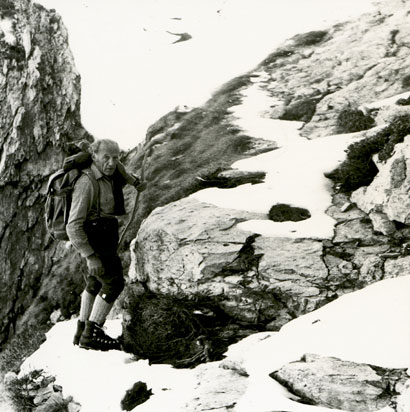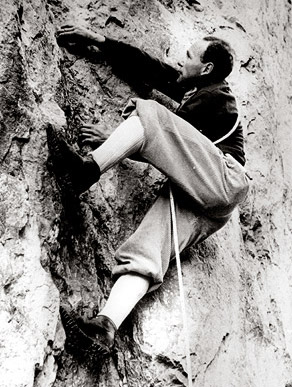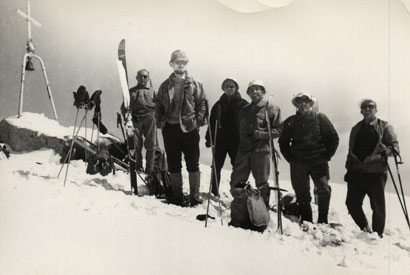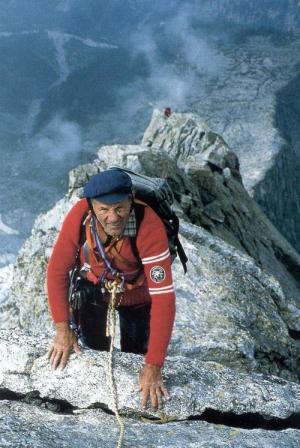
Riccardo Cassin (photo courtesy of Fondazione Cassin)
. ski history : Riccardo Cassin: Mountaineer whose exploits across five decades gave him legendary status - 20 August 2009 - 11:00
Riccardo Cassin came to have the status of a god in the climbing world. The Italian alpinist's greatest routes, the Walker Spur on the Grandes Jorasses, done in 1938, and the Cassin Ridge on Mt McKinley, remain among the sport's most coveted prizes. And was there was not a touch of immortality about a man able to repeat his daring line up the North-East Face of Piz Badile in the Swiss Breggalia, 50 years after making its first ascent? Cassin was still with us, aged 99, when alpinists raised a collective cheer a remarkable 70 years after his first ascent of the incomparable "Walker", and then came all the congratulations and brouhaha of his 100th birthday in January this year.

Riccardo Cassin (photo courtesy of Fondazione Cassin)
Cassin's stock was not always so high, at least not in the eyes of the British mountaineering establishment. The old guard of the Alpine Club regarded the methods used in the 1930s by Cassin and a new wave of continental climbers to scale the vertical walls of the Dolomites and the great north faces of Alps as cheating. Particularly abhorrent was the practise of hammering of pitons (metal spikes) into the rock to "aid" or safeguard an ascent.
This disdain may also have had a cultural undertone. Cassin, like many of his contemporaries, was a working class lad at time when alpinism, from a British perspective, was still the preserve of gentlemen. The social revolution that saw northern tradesmen such as Don Whillans and Joe Brown in the van of a surge in domestic climbing standards, quickly extended to the Alps, did not occur for another 20 years. By then the ambitious Italian was leaving his mark in the Himalaya.
A few months ago, as Cassin entered his 101st year, the Alpine Club accorded him an overdue honorary membership. The certificate was accepted by one of his sons, Guido, at a dinner in Chamonix, France, in May. By then Riccardo was too frail to travel, but he wrote a gracious letter to the Club wishing "good climbing to everybody". He died at his Piani Resinelli home near Lecco, northern Italy on 6 August.
Riccardo Cassin was born in San Vito al Tagliamento, lower Fruili. His parents were peasants and Riccardo started work at age 12 as a bellows-boy in a blacksmith's shop. He had no memory of his father. Cassin senior went to America when Riccardo was two and was killed in an accident at work. Looking to better himself, the young Cassin moved to Lecco in northern Italy and took a job as a mechanic.
Lecco lies on the southern fringe of the Alps by Lake Como and is overlooked by the rock faces of the Resegone. The mountains cast the spell of a lifetime on Cassin. On his first Sunday in Lecco, he went with friends up Punta Cermenati, the main peak of the Resegone, and two weeks later he discovered the Grigna. This popular climbing area north of the city was to become Cassin's training ground and the scene of a string of first ascents in the early 1930s. The first was the East Face of the Guglia Angelina, climbed with Mary Varale, who later introduced Cassin to the Trieste ace Emilio Comici.
Regarded as a supreme stylist on rock, Comici tutored the Lecco boys in the "aid climbing" techniques he had used to remarkable effect on the gleaming towers of the Dolomites – the use of pitons, double roping, and etriers (short rope "ladders" that can be clipped to a piton and stepped up in). These artificial wiles had already been adopted by the German and Austrian avant-garde, opening the way on to seemingly blank, vertical or overhanging rock that otherwise would be unthinkable.

The young Riccardo Cassin climbing
To Colonel Edward Strutt, editor of the Alpine Journal, these were the methods of "steeple-jacks" on factory chimneys. It was, he thundered, a repulsive farce that could only bring discredit on mountaineering. When British climbers got out to the Alps after the Second World War and gazed up at these new hard routes, criticism largely evaporated.
Cassin acknowledged the purity of his free-climbing ethic and claimed to keep his home-made pitons to a minimum. "On routes where I had used 50 pitons, other people used 70. So I climbed with less aid than other climbers," he said. He admired the audacious Austrian Paul Preuss, a great advocate of free climbing, but when Pruess fell to his death aged only 27, while attempting a solo first ascent in the Gosaukamm, Cassin observed drily that he had become "a victim of his own theories".
After their Grigna apprenticeship, Cassin and his Lecco friends in the Nuova Italia Club moved on to the Dolomites. In 1935, he and Vittorio Ratti authored a masterpiece on the gigantic Torre Trieste, a 50-hour climb up the tower's exposed South-east Ridge. The beauty of the Cassin/Ratti line was reflected in the comment of one observer who told them: "On those 700 metres of rock you wrote a poem."
Lecco was a nursery of talented rock climbers, whose skills combined with Cassin's power and determination (he was a boxer as a youth) spelt success where others quailed. This was strikingly evident in what he called his "Alpine Triad" – first ascents of three formidable north faces, battered by storms on each occasion. First, in 1935, came the North Face of the Cima Ovest di Lavaredo, a 60-hour epic, enduring lightning, hail and snow. Always highly competitive, Cassin had raced to the Dolomites on hearing that two Germans were encamped below the Face waiting for the weather to clear. On returning victorious to Lecco, he and Ratti were welcomed by the town band.
Next in the Triad, in 1937, was the North-East Face of Piz Badile in wild Val Bondasca, just over the border in Switzerland. Cassin and Ratti were joined by Gino Esposito. Success, however, was marred by the death of two Como climbers who asked to join forces with the Lecco trio at the first bivouac. Cassin could hardly refuse, but the pair proved unprepared for a 52-hour ordeal on such a face and died on the descent from cold and exhaustion. These were the only deaths associated with a Cassin climb, a remarkable record given the seriousness of his routes over such a long career.
All eyes were now on the North Face of the Eiger. Climbers were literally dying in the race to be first up the Nordwand, or Mordwand (murder wall) as it was often dubbed in the press. Hitler was offering medals for valour – presuming it would be climbed first by Germans – while the gentleman of the Alpine Club regarded it all as "an obsession for the deranged". Cassin, Esposito and Ugo Tizzoni arrived at Kleine Scheidegg, beneath the Wall, just in time to watch the Germans Heckmair and Vörg and the Austrians Kasparek and Harrer take the prize.
Cassin thought hard for an alternative and set out a week later with Esposito and Tizzoni for the Mont Blanc range, intent on a dirrettissima of the North Face of the Grandes Jorasses, on the Walker Spur. This was wonderfully audacious. None of the trio had ever visited the Mont Blanc group and they had to get directions to the face from a hut warden, dumbfounded at their naivety. Once at the Leschaux glacier there isn't much doubt: the face rises 1,200m to a serrated crest with five peaks exceeding 4,000m. Pointe Walker (4,208m) is the highest, with the rock Spur rising straight to its summit.
The Walker was to be Cassin's greatest climb, completed over 82 hours with, as ever, a lashing from the elements. He led throughout, penduluming beneath the most awkward overhang and hammering in a total of 50 pitons – "not that many" over such a distance in the opinion of Chris Bonington. Cassin had created what is still regarded as the most prestigious route in the Alps.
War put climbing on hold. Cassin joined the partisans but kept his job in a factory producing military equipment – a reserved occupation – to avoid suspicion. He became the leader of a climbers' section, liaising with partisans in the mountains and hiding arms and ammunition in his house. Lecco was strategically important and the scene of fierce street fighting in April 1945. Cassin's close friend Vittorio Ratti was shot dead at his side in one exchange while Cassin himself was injured in the arm and face.
After the war, Cassin's life as an alpinist matured. He turned more to the greater ranges for adventure and adopted a father role to the next generation of Italian climbers. In 1946 he was asked to be the leader of a newly-formed group of activists, the Ragni della Grignetta or "Lecco Spiders". More first ascents and some notable repeats followed. Today, when so many top climbers turn professional, it is sobering to note that Cassin crammed his routes into holidays and weekends, and was always back at his bench on Monday morning. Later it was a desk, as he rose from shop floor to manager and then founded his own company manufacturing crampons, ice axes and other climbing paraphernalia.
In 1953 came his first trip to the great peaks of Asia, and with it the seeds of bitterness. Professor Ardito Desio was organising a major expedition to K2, then unclimbed, intent on planting the Italian flag on the world's second highest summit. Cassin escorted Desio on a reconnaissance up the Baltoro glacier, spending 32 days on the march. But to his intense disappointment and anger he was excluded from the main expedition the following year. (It was successful, but not a happy show.)
Purportedly, Cassin was dropped on health grounds, but he believes the professor was afraid of being overshadowed by a "simple" climber who was a sporting hero to Italians. Both men regarded themselves as leaders, and the autocratic scientist was unlikely to have taken kindly to advice from a former bellows-boy. Cassin's retort came in the autumn of 1957 when he returned to the Baltoro as leader of an expedition to the magnificent Gasherbrum IV. Walter Bonatti and Carlo Mauri reached the 7,925m-summit after some of the hardest technical climbing then accomplished at altitude.
Cassin's reputation as an indomitable alpinist was sealed with his 1961 success on Mt McKinley (6,194m) in Alaska, the highest mountain in North America. With five of his "boys" from the Lecco Spiders he made a first ascent of McKinley's south face by an elegant spur that bears his name – the Cassin Ridge. It was a post-war equivalent of the Walker Spur, a line of steep ice and rock that remains an absolute classic. The climbers endured violent storms and extreme cold, several of them suffering frostbite on an epic descent as snow fell continuously for 75 hours. Cassin called it "a superb victory for Lecco" and the expedition received congratulatory telegrams from the presidents of the USA and Italy, Kennedy and Gronchi.
Expeditions followed to the Caucasus (1966) and the Andes, where in 1969 he led the first ascent of the west face of Jirishanca (6,126m), a slender pyramid sometimes compared to the Matterhorn. All six team members reached the summit with its cornice of fragile ice. Cassin was indescribably happy. "With 60 years behind me, and those good lads beside me, I looked at the world from that peak: my mind seemed drugged by infinite silence."

Giancarlo Riva, Vasco Cocchi, Gianni Lenti, Mario Bonacina, Ugo Lorenzi and Riccardo Cassin in Vetta all'Adamello (June 1966)
Most mountaineers would be powering down by this stage in life, but Cassin was still hungry. In 1975 he returned to the Himalaya as leader of a CAI (Italian Alpine Club) attempt on the south face of Lhotse (8,501m) in Nepal. The precipitous 3,000m wall of the world's fourth highest peak had "last great problem" status stamped all over it, but though the team made good progress and reached 7,500m, the elements proved too severe. After a second avalanche smashed through base camp, Cassin reluctantly conceded defeat.
It was the first time a mountain had forced Cassin to back down and "failure", as he viewed it, was a psychological blow. Even so, he rejected Reinhold Messner's description of him as being "destroyed". Messner, from Süd Tirol, had been one of the strongest performers on the face and would go on to become the first man to climb all 14 of the world's 8,000m peaks. His presence on Lhotse with the 66-year old Cassin has a certain symbolism. The baton of Italian alpinism had passed on.

Riccardo Cassin: “I always brought home everyone who came along and never lost a friend on a rope.”
Lhotse was Cassin's last big trip, though he continued to climb rock at a high standard. With three sons and a clutch of grandchildren, he devoted himself to family life, the "Cassin" factory and his role as an elder statesman of alpinism. In 1987, on the 50th anniversary of his first ascent of the North-East Face of Piz Badile, the Lecco legend turned in a bravura performance, climbing the route twice in one week – the second time for the benefit for the late-arriving press. He was 78 years old, on a route still beyond most recreational climbers despite all the advances in risk-reducing equipment. Such was the will of Riccardo Cassin.
Riccardo Cassin, alpinist: born Savorgagno, lower Fruili, Italy 2 January 1909; married 1940 Irma (three sons); died Piani Resinelli, Lecco, Italy 6 August 2009.
By Stephen Goodwin
The Independent, UK
Thursday, 13 August 2009